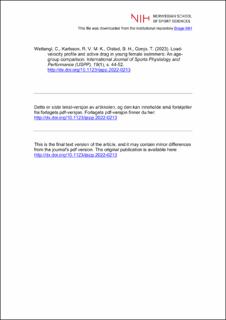| dc.contributor.author | Wettengl, Christina | |
| dc.contributor.author | Karlsson, Rebecca Vilde Martine Krohn | |
| dc.contributor.author | Olstad, Bjørn Harald | |
| dc.contributor.author | Gonjo, Tomohiro | |
| dc.date.accessioned | 2024-04-12T08:37:14Z | |
| dc.date.available | 2024-04-12T08:37:14Z | |
| dc.date.created | 2024-01-16T13:05:45Z | |
| dc.date.issued | 2023 | |
| dc.identifier.citation | International Journal of Sports Physiology and Performance (IJSPP). 2023, 19(1), 44-52. | en_US |
| dc.identifier.issn | 1555-0265 | |
| dc.identifier.uri | https://hdl.handle.net/11250/3126228 | |
| dc.description | I Brage finner du siste tekst-versjon av artikkelen, og den kan inneholde ubetydelige forskjeller fra forlagets pdf-versjon. Forlagets pdf-versjon finner du på journals.humankinetics.com / In Brage you'll find the final text version of the article, and it may contain insignificant differences from the journal's pdf version. The definitive version is available at journals.humankinetics.com | en_US |
| dc.description.abstract | Purpose: The present study aimed to establish differences in load–velocity profiling, active drag (AD), and drag coefficient (Cd) between 3 age groups of female swimmers. Methods: Thirty-three swimmers (11, 13, or 16 y old) were recruited. The individual load–velocity profile was determined for the 4 competitive swimming strokes. The maximal velocity (V0), maximal load (L0), L0 normalized to the body mass, AD, and Cd were compared between the groups. A 2-way analysis of variance and correlation analysis were conducted. Results: Compared with their younger counterparts, 16-year-old swimmers generally had larger V0, L0, and AD, which was particularly evident when comparing them with 11-year-old swimmers (P ≤ .052). The exception was breaststroke, where no differences were observed in L0 and AD and Cd was smaller in the 16-year-old group than the 11-year-old group (P = .03). There was a negative correlation between Cd and V0 for all groups in backstroke (P ≤ .038) and for the 11-year-old group and 13-year-old group in breaststroke (P ≤ .022) and front crawl (P ≤ .010). For the 16-year-old group, large correlations with V0 were observed for L0, L0 normalized to the body mass, and AD (P ≤ .010) in breaststroke and for L0 and AD with V0 in front crawl (P ≤ .042). In butterfly, large negative correlations with V0 were observed in the 13-year-old group for all parameters (P ≤ .027). Conclusions: Greater propulsive force is likely the factor that differentiates the oldest age group from the younger groups, except for breaststroke, where a lower Cd (implying a better technique) is evident in the oldest group. | en_US |
| dc.language.iso | eng | en_US |
| dc.subject | swimming | en_US |
| dc.subject | semitethered | en_US |
| dc.subject | strength | en_US |
| dc.subject | technique | en_US |
| dc.title | Load-Velocity Profile and Active Drag in Young Female Swimmers: An Age-Group Comparison | en_US |
| dc.title.alternative | Load-Velocity Profile and Active Drag in Young Female Swimmers: An Age-Group Comparison | en_US |
| dc.type | Peer reviewed | en_US |
| dc.type | Journal article | en_US |
| dc.description.version | acceptedVersion | en_US |
| dc.source.pagenumber | 44-52 | en_US |
| dc.source.volume | 19 | en_US |
| dc.source.journal | International Journal of Sports Physiology and Performance (IJSPP) | en_US |
| dc.source.issue | 1 | en_US |
| dc.identifier.doi | 10.1123/ijspp.2022-0213 | |
| dc.identifier.cristin | 2227702 | |
| dc.description.localcode | Institutt for fysisk prestasjonsevne / Department of Physical Performance | en_US |
| cristin.ispublished | true | |
| cristin.fulltext | postprint | |
| cristin.qualitycode | 1 | |
